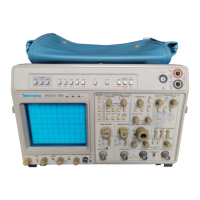Operation
Normal mode produces a sweep only when the trigger signal meets the Level
and
Slope criteria.
Use
Normal mode for infrequent events
and
erratic signals.
Sgl
Seq
mode accepts one trigger for each sweep
in
the display. Press the
lower Mode button to
arm
the trigger
and
illuminate the READY indicator for
each sequence. With a multi-trace display, a sequence comprises
up
to sixteen
sweeps.
Use
Sgl Seq to detect a rare event or to eliminate
all
but the first one of a
chaotic burst of pulses. Set the trigger for the signal of interest
in
Normal mode.
Then press the
lower Mode button to select
8g1
Seq
and
illuminate the READY
indicator. To detect the occurrence of a rare event,
display a single trace
and
arm
8g1
Seq with the trigger set for the event. Periodically check to see
if
READY
is
on. If a burst of trigger events occurs, the sweep runs once for each
trace displayed
and
READY extinguishes.
Trigger Source
Choose a single trigger source to correctly display the timing relationships
among multiple channels. Choose the channel with the lowest-frequency signal
to avoid ambiguous displays.
With Vert trigger source, Auto
Lvi
trigger mode or Chop vertical mode
automatically selects a single trigger source, the first one of the displayed
channels.
Use
a composite A-Trigger source only to compare asynchronous signals.
To generate a composite trigger, select Vert trigger source, a trigger mode
other than Auto Lvi,
and
Alt vertical mode.
Trigger Coupling
For noisy signals or signals with strongly interfering components, Noise
Reject, HF Reject,
and
LF
Reject coupling give added selectivity.
AC
coupling
continues triggering when the dc level of the signal changes.
2465A/2455A/2445A Operators
2-5

